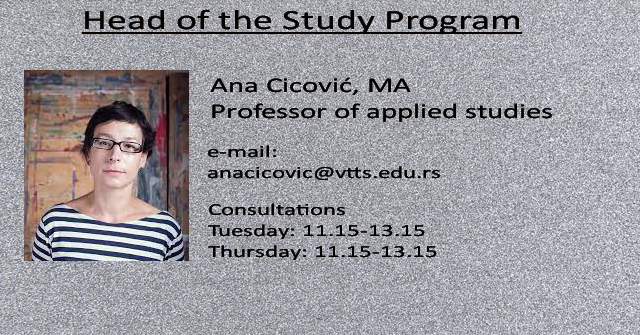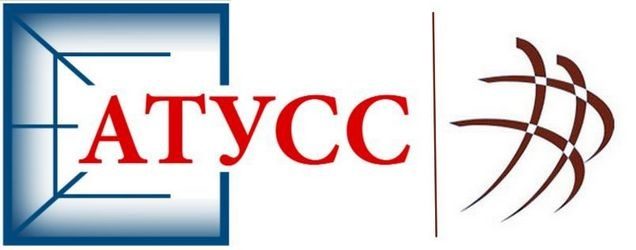
General information
Basic applied studies take three years, or six semesters. All student activities are graded according to the European Credit Transfer System (ECTS), so that each semester carries 30 ECTS points. Upon a successful completion of the studies, the total number of ECTS points obtained is 180. The studies are realized in the form of traditional classroom teaching, in Serbian. This study program belongs to the broader educational field of art, and the artistic fieldapplied arts and design. Upon finishing basic applied studies, the student is awarded the title „Bachelor of Applied Design“, or „BaAppDe“ / „B.A.D“ for short.
Qualification
According to the National Qualifications Framework in Serbia (NOKS), upon finishing basic applied studies the student reaches level six, sublevel one (level 6.1). To reach this level, the student is first required to have a high school degree and to pass the entrance exam.
Classes and exams
All of the courses at this study program take one semester to finish. Student activities throughout the semester (pre-exam obligations), such as attendance and active participation in class, practical work, mid-term exams, test, papers and homework are all awarded a certain number of points. The ratio between the number of points obtained through the fulfilment of pre-exam obligations and the points obtained at the final exam is established for each individual course separately; the pre-exam obligations can carry a minimum of 30, and a maximum of 70 points. The final exams take place on-site, at the Department, in the appropriate exam terms, which are: January, February, June, July, Spetember and October. By fulfiling the pre-exam obligations and passing the final exam, the student can achieve a maximum of 100 points; for a grade of „6“, 51 points are needed; for „7“, 61 points; for „8“, 71 points; for „9“, 81 points; for „10“, 91 points.
Goals and outcomes
The basic goalof the Textile and Apparel Design study program is to achieve academic and vocational knowledge, competences and skills oriented towards textile and apparel design. The goal of realization of the Textile and Apparel Design study program is to provide the students with ample knowledge and skills, to stimulate the creativity and problem-solving abilities through practical work and modern teaching methods, helping the graduates to develop a successful career in the textile sector.
The goals of the Textile and Apparel Design program include:
- The development of professional and creative abilities, creative thinking and inventive spirit, the development of teamwork, cooperation and communication skills of the student, i.e. the future Bachelor of Applied Design.
- Mastering specific practical skills needed for their profession, such as:
- the ability to express themselves artistically when designing textile and clothing by applying different methods, techniques and materials;
- the ability to independently design a collection in different fields of the fashion and textile industry;
- presenting and defending their work, ideas and concepts through multimedia or graphic presentations;
- creating unique textile and garments through the application of modern methods and conceptual solutions;
- identifying textures and types of textile fibers and materials, and applying basic technological procedures to produce woven, knitted and non-woven textile;
- basic construction and modeling of certain items of women’s, men’s and children’s clothing;
- applying modern procedures in apparel technology;
- applying computer-aided textile and apparel design.
- Providing sufficient knowledge and competences that allow the Bachelor of Applied Design to build a successful career through team work and individual efforts in design centres, small, medium-sized and large companies that are mostly dedicated to the realization of textile and apparel products and services; also, to allow the graduate to independently implement their knowledge into their own production of textile and clothing.
- Thanks to a study program conceptualized as a symbiosis of art, technology, information technology, marketing, management and other artistic and scientific disciplines, the future Bachelor of Applied Design will be qualified to apply the obtained knowledge in all segments of textile and apparel shaping, and to actively influence the development of design within the textile industry.
- Involving the student in complex creative work within textile industry enterprises and on individual design projects.
- Considering the characteristics and the significance of this study program, the textile and apparel industry stand to benefit from it through the creation of an environment more conducive to high-quality, creative activities within the manufacturing, professional and humane fields.
The competences of future students
Upon finishing this study program, the student will have gained the following subject-specific abilities:
- from the field pertaining to social sciences and humanities, the student gains knowledge which supports art subjects, the theory of art and professional and applicative subjects;
- from the field pertaining to the theory of art, they know and understand: the evolution of costume; different aspects of clothing and fashion; different manufacturing levels within the fashion industry; fashion trends; technology innovations; basic principles of design and the basics of digital textile and apparel design;
- from the field pertaining to art subjects, the student knows and understands: artistic expression through the use of different artistic elements and techniques; proportions of the human body, with the goal of implementing this knowledge in fashion and technical drawing; different fields of the fashion and textile industry, focusing in particular on the mass production of textile, women’s, men’s and children’s clothing; the skills of presenting and defending their ideas by adopting the principles of presentation (using multimedia or graphics); the transposition of apparel forms; creating unique textile and clothing by applying modern methods and ceonceptual solutions;
- from the field pertaining to professional and applicative subjects, the student knows and understands: textile fibers and the structure and characteristics of woven, knitted and non-woven material; the technology of creating textile surfaces with the goal of shaping woven, knitted and non-woven unique textiles; the application of modern methods in printed textile technology; the design process; designing, constructing and modeling men’s, women’s and children’s clothing in a conventional and contemporary manner.
Solving concrete problems by applying different methods within the design process:
- drawing and painting still life and human figures;
- applying artistic elements in textile and apparel design;
- tracking all project stages in textile and apparel design;
- designing and creating finished textile and apparel products;
- adjusting the construction of the pattern to the proportions of the human body;
- creating specific clothing elements and the ability to implement them within the pattern;
- designing and presenting textile and fashion products with the support of digital technologies;
- creating textile samples on different types of looms;
- designing and creating fashion accessories;
- presenting fashion collections through different fashion presentations;
- creating a visual identity within a fashion collection.
Connecting the basic knowledge of different fields: textile and apparel design; textile technology, apparel technology, management and general subjects and applications within the design process:
- keeping up with innovative solutions through professional literature, the internet and other media, and applying them in practice;
- developing skills and dexterity in applying the knowledge of textile and apparel design according to the demands of the market and the changes in fashion trends;
- applying information and communication technologies in mastering modern working methods and keeping up with new tendencies and innovations in the fields of textile and apparel design.
Further studies
The Textile and Apparel Design program of MASTER applied studies is currently in the process of accreditation, which will allow the graduates of the basic applied studies to continue their education, both through this program of MASTER applied studies and other MASTER programs offered by the Department.
| The TEXTILE AND APPAREL DESIGN program of basic applied studies was accredited in 2017. | |||
| Code | Course Title | Status | ECTS |
| FIRST YEAR | |||
| 1st Semester | |||
| ISU114009 | History of Art | Compulsory | 7 |
| CIS116010 | Drawing and Painting | Compulsory | 6 |
| NGP113011 | Descriptive Geometry and Perspective | Compulsory | 6 |
| MEN114005 | Product Management | Compulsory | 6 |
| LEK115012 | Artistic Elements and Composition | Compulsory | 5 |
| 2nd Semester | |||
| MIO115019 | Fashion and Clothing | Compulsory | 5 |
| TVL113016 | Textile Fibers | Compulsory | 7 |
| AKT116012 | Art Nude | Compulsory | 6 |
| RAČ113026 | Computers | Compulsory | 6 |
| ENG114007 | English | Compulsory | 6 |
| SECOND YEAR | |||
| 3rd Semester | |||
| DTP115032 | Woven and Knitted Fabric Design 1 | Compulsory | 5 |
| KOS115033 | Costume Design 1 | Compulsory | 6 |
| OOD115034 | Clothing Basics 1 | Compulsory | 5 |
| TTN113025 | Woven and Nonwoven Fabric Technology | Compulsory | 7 |
| OKM113021 | The Basic of Garment Construction Modeling | Compulsory | 7 |
| 4th Semester | |||
| OOD116052 | Clothing Basics 2 | Compulsory | 5 |
| TPT113039 | Knitted Fabric Technology | Compulsory | 5 |
| DTP116053 | Woven and Knitted Fabric Design 2 | Compulsory | 5 |
| KOS116054 | Costume Design 2 | Compulsory | 5 |
| TMA113180 | Textile Materials | Compulsory | 3 |
| MOD113120 | Garment Modeling 1 | Compulsory | 5 |
| STP116185 | Internship 1 | Compulsory | 2 |
| THIRD YEAR | |||
| 5th Semester | |||
| MDI115067 | Fashion Design 1 | Compulsory | 6 |
| DŠT115069 | Printed Textile Design 1 | Compulsory | 5 |
| DTO116070 | Digital Textile and Apparel Design 1 | Compulsory | 7 |
| PDZ113122 | The Design Process | Compulsory | 7 |
| The students choose one of the following electives | |||
| DNT116036 | Nonwoven Textile Design | Elective | 5 |
| MIL116081 | Fashion Illustration | Elective | 5 |
| MOD113121 | Garment Modeling 2 | Elective | 5 |
| 6th Semester | |||
| DŠT116075 | Printed Textile Design 2 | Compulsory | 5 |
| DTO116076 | Digital Textile and Apparel Design 2 | Compulsory | 5 |
| MDI116077 | Fashion Design 2 | Compulsory | 5 |
| The students choose one of the following electives | |||
| DUT116122 | Unique Textile Design | Elective | 5 |
| TPR116082 | Presentation Techniques | Elective | 5 |
| TOF116083 | The Transposition of Appareal Forms | Elective | 5 |
| STP116084 | Internship 2 | Compulsory | 4 |
| ZVR116086 | Final Paper | Compulsory | 6 |
